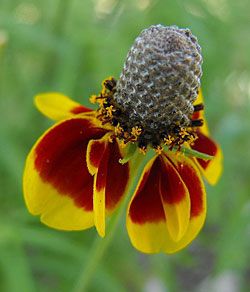Mexican Hat

Ratibida columnifera
Family: Asteraceae (Aster Family)
Mexican Hat (Ratibida columnifera) is a striking native wildflower found throughout Texas, including Southeast Texas. Recognized for its distinctive drooping petals and tall, cone-shaped center, this hardy perennial is a favorite in prairies, pollinator gardens, and roadside plantings. It is drought-tolerant and thrives in a variety of soil conditions, making it a versatile addition to native landscapes.
- Scientific Name: Ratibida columnifera
- Common Names: Mexican Hat, Prairie Coneflower, Upright Prairie Coneflower
- Family: Asteraceae (Aster Family)
- Growth Habit: Upright, clump-forming perennial or biennial
- Height: 1-3 feet
- Leaves: Deeply lobed, feathery green foliage
- Flowers: Distinctive red, yellow, or bi-colored petals surrounding a tall, brown central cone
- Bloom Time: Late spring to fall
- Wildlife Benefits: Attracts bees, butterflies, and other pollinators
Habitat & Range in Southeast Texas
Mexican Hat is commonly found in:
- Open Prairies & Grasslands: Thrives in full sun and well-drained soils
- Roadside & Meadow Plantings: Often used in wildflower mixes for erosion control and beautification
- Disturbed Sites & Dry Slopes: Can establish in poor or rocky soils
This adaptable species prefers dry to moderately moist soils and is highly tolerant of drought conditions.
Ecological Importance
- Pollinator Support: Provides nectar and pollen for bees, butterflies, and other beneficial insects.
- Erosion Control: Deep root systems help stabilize soils in open landscapes.
- Wildlife Habitat: Seeds are a food source for small birds, particularly finches.
Landscaping & Gardening Uses
Mexican Hat is a great choice for low-maintenance wildflower gardens and native plant landscapes:
- Meadow & Prairie Gardens: Blends well with other native wildflowers and grasses.
- Pollinator & Butterfly Gardens: Provides a long-lasting nectar source.
- Drought-Tolerant Landscaping: Thrives in dry, poor soils with minimal watering needs.
Planting & Care
- Sunlight: Full sun
- Soil: Well-drained, sandy or loamy soils; tolerates poor soil
- Water Needs: Low; highly drought-tolerant
- Maintenance: Minimal; occasional deadheading can prolong bloom period
- Companion Plants: Pairs well with Black-eyed Susan (Rudbeckia hirta), Little Bluestem (Schizachyrium scoparium), and Purple Coneflower (Echinacea purpurea)
Fun Facts
- The common name "Mexican Hat" comes from its resemblance to a traditional sombrero.
- It is often included in wildflower seed mixes to enhance biodiversity and natural beauty.
- Indigenous peoples used parts of the plant for medicinal purposes, including teas for fever relief.
Conservation & Native Plant Advocacy
Adding Mexican Hat to your landscape helps support native pollinators and promotes biodiversity. This resilient wildflower is an excellent choice for sustainable gardening, habitat restoration, and prairie conservation efforts.
Where to Find It
-
Interested in adding Mexican Hat to your garden? Check if this is in stock or add to cart to purchase directly from our Natives Nursery.


